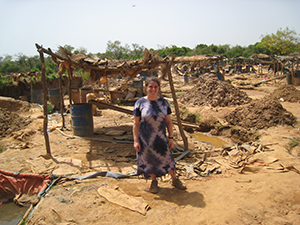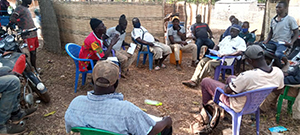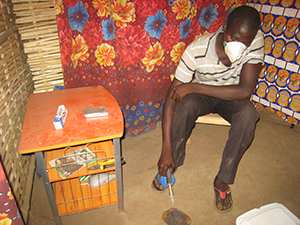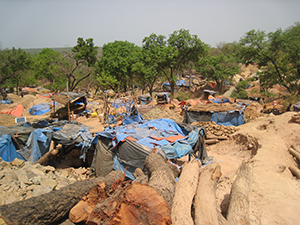Detoxifying gold mining
Article Highlights
- Artisanal and small-scale gold mining, or ASGM, accounts for about 20% of the world’s gold supply and nearly 40% of global mercury emissions.
- A new paper from Jacqueline “Jackie” Gerson of Michigan State University shows that, when developed in partnership with mining communities, education paired with devices called retorts can reduce mercury emissions from ASGM operations in Senegal.
- Gerson is also helping lead a new grant that will explore where mercury emissions from ASGM go and whether and how the mercury enters crops in nearby areas — a critical but understudied component of environmental and public health in these communities.
Jacqueline “Jackie” Gerson knows very well how “artisanal gold mining” sounds to people who haven’t heard the phrase before.
“It sounds quaint, right?” asked the assistant professor of earth and environmental sciences in Michigan State University’s College of Natural Science.
But that innocuous name belies the dangers of a practice that exposes miners and their communities to a poisonous chemical that’s been banned by an international treaty. So, when Gerson thinks of artisanal gold mining, her mental image is anything but quaint.
“I think of it like the Wild West days in the United States,” said Gerson. “During the gold rush here, people were using mercury to extract gold. That’s exactly what’s happening now in these artisanal and small-scale gold mines.”

Artisanal and small-scale gold mining, abbreviated ASGM, supplies about 20% of the gold bought and sold around the world, said Gerson. Gerson is also a faculty member with the W.K. Kellogg Biological Station and the Ecology, Evolution and Behavior, or EEB, program at MSU.
At the same time, ASGM accounts for almost 40% of the global emissions of mercury — a neurotoxic metal — into the atmosphere. That’s more than any other source, including the burning of fossil fuels, which are naturally laced with trace amounts of mercury.
What becomes of that atmospheric mercury largely remains a mystery. To better understand the fate of this heavy, unhealthy metal, Gerson, her lab and her colleagues have been awarded a $1.5 million grant from the National Science Foundation.
In the meantime, she’s also part of a team that’s been working with miners and their communities to reduce mercury emissions. And they have piloted an approach that can do just that, which they have now reported in the journal Cleaner Production Letters.
What is artisanal mining?
In the context of mining, “artisanal” is all about the word’s denotation, rather than its charming connotations that we tend to associate with things like cheese, chocolate and coffee.

“Artisanal means the miners are using very rudimentary approaches, without modern technology,” Gerson said. “And they’re small-scale, meaning small groups of people, but in a given community, there can be hundreds or thousands of people mining.”
Miners dig up ore and sediment containing gold, then add mercury to help extract the precious metal. They then burn the mercury off — often in huts where miners and their families live — leaving the gold behind.
The process is cheap, easy and accessible. That’s why miners used it over a century ago during the gold rush in the U.S. What’s different today is that mercury is outlawed.
“Artisanal mines are almost always illegal,” Gerson said. “But miners can buy mercury on the black market.”
In 2013, more than 140 countries signed a United Nations treaty called the Minamata Convention on Mercury, which went into effect in 2017 to curb mercury emissions, including those from ASGM.
The treaty is named after the Japanese city of Minamata, where, in the mid-20th century, thousands of residents were poisoned by mercury from industrial pollution. The exposure led to many adverse health outcomes including death, paralysis and neurological disease.

Today, mercury poisoning typically isn’t something people in the U.S. or other developed and densely populated countries worry about (a notable exception is people who are pregnant and must avoid certain types of seafood that can have elevated levels of mercury, which disrupts fetal development).
In developing nations and remote areas, however, ASGM operations can thrive because of lax or nonexistent regulatory enforcement. Artisanal gold mines are operating in more than 70 countries worldwide, mostly in the southern hemisphere.
Artisanal and small-scale miners sell their gold to dealers who introduce it into the global supply, where it’s indistinguishable from gold mined in accordance with the Minamata Convention. That means, if you own gold jewelry, some of that metal probably came from artisanal gold mines.
“They are a major source of gold,” Gerson said. “It’s a global issue, and we’re all part of it, whether we want to admit it or not.”
Making mining safer
Although most artisanal miners understand that the mercury they work with is dangerous, they accept that risk to support themselves and their families.

Research from Michigan State University shows that education provided by trusted sources in a community can be a potent intervention strategy for reducing mercury usage in and emissions from artisanal and small-scale gold mining. Credit: Courtesy Falaye Danfakha
Researchers have been working to try and help these miners keep their livelihoods while reducing its associated health risks. Most new approaches, however, focus on replacing mercury with techniques or technologies that are more expensive or harder to use than the toxic metal.
“Getting rid of the mercury is the most ideal solution,” Gerson said. “But studies show these approaches just aren’t being picked up.”
So, Gerson decided to try a different approach working with collaborators at Colorado State University, the Peace Corps and Duke University. Gerson started this work while she was a doctoral student at Duke, and the project was supported by the Duke University Global Health Institute and World Connect.
The researchers’ approach started with talking with miners in Senegal to identify emission-reducing opportunities that would stick. Using what they learned, the team developed an approach based on two pillars.
The first was an educational program, delivered by trusted, local community members about the dangers of mercury, the symptoms of exposure and ways miners could protect themselves.

The instructors also shared information about the second pillar, devices known as retorts.
Retorts are metal enclosures that allow miners to burn the mercury off from gold without releasing vapors into the atmosphere. Instead, the vapors are collected and exhausted into a bucket of water, where the mercury condenses and can be retrieved.
Local metal workers built the retorts for the study using readily available materials and a design provided by the research team that also incorporated tweaks from the miners.
The team worked with nine mining communities to measure the effects of these interventions. Three of the communities received both the education and retorts, three received education only and three provided a control group — that is, they received neither the education nor the retorts.
This enabled the team to conclusively demonstrate that providing education and retorts worked. Miners were more aware of the dangers of mercury and how they could limit their exposure. They used mercury less and, when they did, they used retorts more.
And that wasn’t all.
“These effects permeated into the control villages,” Gerson said. “There was this sort of social spillover where people were sharing the education and the retorts.”
Based on the project’s success in Senegal, Gerson believes the approach could be extended to mining operations in other countries to further curb emissions. But she stressed that it has to be the entire approach, not just the solutions they found in Senegal.
“Miners have to be involved from the beginning to identify specific solutions that will work in their unique physical and social environments,” Gerson said.
Artisanal mining in Senegal is different from artisanal mining in Peru, for example. So the specific techniques that worked in Senegal may not work in Peru, but the approach of working with miners and their neighbors to find trustworthy solutions will translate.
“That’s a theme in my work,” Gerson said. “We have to collaborate with the people who are living and working in these places if we’re going to be successful.”
‘That’s what we hope, but we don’t know’
That theme is also evident in Gerson’s new $1.5 million NSF grant, which is working to better understand the fate of mercury emitted from ASGM operations.
The grant is a collaboration led by Gerson, Associate Professor Heidi Hausermann at Colorado State University and Professor Richard Amankwah, who is the vice chancellor at the University of Mines and Technology in Ghana.

In conventional artisanal gold mining, miners use mercury to extract gold from ore and then isolate the gold by burning off the mercury using rudimentary means. By partnering with mining communities, Michigan State University researchers are introducing education and techniques that help reduce mercury emissions from mining. Credit: Courtesy Jacqueline Gerson
Hausermann, who was also an author on the new Cleaner Production Letters article, has been working with Ghanaian collaborators on ASGM research for a dozen years. Amankwah is a mining engineering and ASGM expert who also has served as a consultant for the World Bank, the United Nations and the World Health Organization.
Together, they’re trying to answer large, looming questions about where mercury emissions from ASGM go and how and whether these mercury emissions can enter the food web through crops.
This knowledge could help create policies and practices to better protect miners, their neighbors and nearby communities.
“Locally and regionally, we don’t know where a lot of that mercury goes once it’s emitted,” Gerson said. “The question is whether crops are taking it up in their leaves or through their roots, and it could be that they don’t. That’d be great. In fact, that’s what we hope, but we don’t know.”
To date, most research on mercury emissions has focused on what happens to it in aquatic environments, which makes sense, Gerson said.
There are microbes living in ecosystems without a lot of oxygen — underwater, for example — that are very efficient at converting mercury into a compound called methyl mercury, which is the form of mercury that causes neurotoxic impacts.

In aquatic environments, then, methyl mercury gets in on the ground floor of the food chain. The chemical accumulates in larger fish and sea life preying on smaller organisms, which is why certain seafoods present mercury concerns for humans. Young children and developing fetuses are especially vulnerable.
With an abundance of oxygen above water, however, research on the fate of methyl mercury on land has been scant.
“We know terrestrial conversion of mercury to methyl mercury is less efficient, but there’s a lot of mercury entering the terrestrial ecosystems near artisanal gold mining,” Gerson said. “So, it is a concern.”
Underscoring that concern is the fact that, during earlier work in Peru, Gerson observed evidence that songbirds in forests near ASGM activity had been exposed to mercury, likely through their diet of fruit and bugs.
Now, with the grant, Gerson and her teammates will track how mercury moves through terrestrial environments and where it ultimately ends up to paint a much more comprehensive picture of its effect on public health.
Also joining the research team are Edith Parker, dean of the College of Public Health at the University of Iowa; Elsie Sunderland, a professor at Harvard University; and Emmanuel Effah, a lecturer at the University of Mines and Technology.
The project will begin Jan. 1, 2024.Banner image: Gold from artisanal and small-scale mining accounts for nearly 20% of the gold bought and sold around the world. The mining also accounts for nearly 40% of global mercury emissions. Researchers at Michigan State University are collaborating with miners and their communities to reduce those emissions and curb their health impacts. Credit: Courtesy Jacqueline Gerson